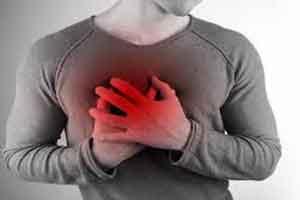- Home
- Editorial
- News
- Practice Guidelines
- Anesthesiology Guidelines
- Cancer Guidelines
- Cardiac Sciences Guidelines
- Critical Care Guidelines
- Dentistry Guidelines
- Dermatology Guidelines
- Diabetes and Endo Guidelines
- Diagnostics Guidelines
- ENT Guidelines
- Featured Practice Guidelines
- Gastroenterology Guidelines
- Geriatrics Guidelines
- Medicine Guidelines
- Nephrology Guidelines
- Neurosciences Guidelines
- Obs and Gynae Guidelines
- Ophthalmology Guidelines
- Orthopaedics Guidelines
- Paediatrics Guidelines
- Psychiatry Guidelines
- Pulmonology Guidelines
- Radiology Guidelines
- Surgery Guidelines
- Urology Guidelines
Sleep Apnea may lead to sudden heart attack and death

The researchers say this study could indicate that Sleep Apnea or sleep-disordered breathing is a factor in the phenomenon of seemingly healthy young athletes dying from a sudden and unexplained heart attack. The study has been published in the Journal ERJ Open Research.
Obstructive sleep apnea is a sleep disorder in which breathing is briefly and repeatedly interrupted during sleep. The "apnea" in sleep apnea refers to a breathing pause that lasts at least ten seconds. It is characterized by abnormal respiratory patterns or pauses in breathing during sleep, ranging from snoring to sleep apnea, where the airways close completely or partially many times during sleep.
Having a high BMI, being over 40 years of age and having a large neck circumference are some of the common factors associated with Sleep Disordered Breathing. If untreated, patients with SDB-related conditions face an increased risk of developing chronic diseases such as cardiovascular disease, heart failure and type 2 diabetes. The most important part of treatment for people with OSA is using the CPAP whenever they sleep. The health benefits of this therapy can be enormous, but only if used correctly.
The study lead researcher Yoshitaka Iso, a cardiologist and Associate Professor at Showa University Research Institute for Sport and Exercise Sciences, Yokohama, Japan said "We wanted to investigate the prevalence of sleep-disordered breathing in collision sport athletes, such as rugby or American-style football players because we know that they usually have a higher BMI and larger neck circumference than athletes from other sports.
"We tend to assume that young, competitive athletes will not experience conditions like SDB, which are more common in people with a higher BMI and inactive lifestyles, but more research is needed to determine what may be contributing to sudden cardiac death in athletes, and SDB is a good candidate for this as it can affect the heart's normal functions."
The study included 42 male rugby players aged 18-19 years. A special device was used to monitor overnight changes in the athletes' breathing rhythm, heartbeats and heart rate, blood oxygen levels, the number of times they woke up, and how long they were awake for.
The data showed that 18 (43%) of the athletes met the criteria for SDB, which means they experienced five or more pauses in breathing that lasted for at least 10 seconds, over a total sleeping time of more than three hours.
The data also showed that athletes with SDB had higher average heart-rates and lower levels of oxygen in their blood than athletes who did not have SDB. They also experienced more periods of time when their blood oxygen levels were unusually low.
Professor Iso and his team then assessed the performance of each young man's heart and lungs at rest and during exercise, to check for cardiovascular abnormalities among athletes with and without SDB. These tests showed that resting heart-rate was higher among SDB athletes and that SDB athletes experienced more incidences of extra or disruptive heartbeats than non-SDB athletes, further suggesting that SDB may be linked to heart abnormalities.
Professor Iso said: "Sleep-disordered breathing was observed in 43% of the young athletes we assessed. This is a higher rate than we expected and is higher still than the levels of SDB reported among middle-aged men from the general population of the US and Europe. Our data also showed that several potential warning signs, such as effects on the athletes' breathing and heart rates, occurred frequently among the athletes with SDB.
"Although none of the athletes in this study were found to have serious conditions yet, likely due to their young ages, we do not know how their conditions may worsen in the future due to associated cardiovascular consequences. Based on the link between SDB and abnormal heart functions that we observed in this group, we speculate that SDB could be a possible factor in the unexplained deaths of some young collision sports athletes, as it appears to be very prevalent but currently is not regularly screened for."
Professor Anita Simonds is a Consultant in Respiratory and Sleep Medicine at Royal Brompton and Harefield NHS Foundation Trust, UK and President-Elect of the European Respiratory Society, and was not involved in the research. She said: "It is too early to conclude that sleep-disordered breathing is a definite factor in sudden cardiac death of athletes, but these results provide food for thought on the ways that breathing disorders may affect the health of young, fit athletes.
"In this study the overall level of sleep-disordered breathing was mild, but the results highlight that a sleep study to assess for the presence of sleep-disordered breathing should be considered in the care of collision sport athletes, such as rugby or American-style football players, as it could help to identify those at risk of cardiovascular complications."
The researchers say that additional large studies are necessary to confirm their results and to determine the underlying mechanisms that lead to SDB, and note that a limitation of the study is that SDB assessment was only performed on a single night.

Disclaimer: This site is primarily intended for healthcare professionals. Any content/information on this website does not replace the advice of medical and/or health professionals and should not be construed as medical/diagnostic advice/endorsement or prescription. Use of this site is subject to our terms of use, privacy policy, advertisement policy. © 2020 Minerva Medical Treatment Pvt Ltd